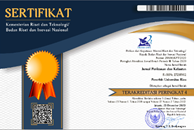Isolasi Bakteri Pendegradasi Minyak Dari Perairan Sekitar Pelabuhan Bengkalis Provinsi Riau
(1)
(2)
(3)
(*) Corresponding Author
Abstract
Keywords
Full Text:
PDFReferences
Ali A. 2005. Mikrobiologi Dasar. Makassar: Universitas Negeri Makassar Press.
APHA. 1981. Standart and Methoda.7th Edition. California:Cumming Publishing Company Inc.
Atlas, R. M dan R. Bartha. 1998. Microbial ecology fundamentals and applications. 4th ed. Benjamin/cummings publishing
company, inc., Menlopark : x + 694 hlm.
Capuccino, J.G dan N. Sherman. 1987. Microbiology: A Laboratory Manual, The Benjamin/ Cummings Publishing Co.
,Inc., California, page 19-179.
_______ . 2002. Microbioly a laboratory manual. 6th ed. Benjamin/cummings publishing company, inc., Menlopark : xvi
+ 491 hlm.
Cooper, F. R. 1990. A Review Probiotic in Man and Animals. Applied Bacteriology. 66:365-378.
Dachniar, H. 2012. Isolasi Bakteri Pendegradasi Minyak Solar Dari Perairan Teluk Pare-Pare. Makasar: Jurnal Biologi UIN Alauddin Makassar. Vol. 4, No. 1:41-46
Medsen, E. L. 2008. Environmental microbiology from genomes to biogeochemistry. Blackwell Publishing, Malden : ix +
hlm.
Monica, Periadnadi. 2015. Isolasi Bakteri Pendegradasi Limbah Cair Industri Minyak Sawit. Padang: Jurnal Biologi Universitas Andalas. Vol. 4, No. 1:71-76
Sharpley, J.M. 1966 Elementary Petroleum Microbiology, Gulf Publishing Company, Texas, 6595:115-117.
Sugianto, I., R. W. Kusumaningtyas, dan F. illaningtyas. 2003. Uji sifat probiotik asam laktat sebagai kandidat bahan pangan fungsional. J. Teknol. Ind. Pangan. 18(2):89-95.
Zam, S. A. 2010. Biodegradtion of diesel oil production of fafly acid esters by
Article Metrics
Abstract view : 706 timesPDF - 811 times
DOI: http://dx.doi.org/10.31258/jpk.23.1.15-20
Copyright (c) 2018 Jurnal Perikanan Dan kelautan
Gedung Marine Center Lt 2. Fakultas Perikanan dan Kelautan Universitas Riau



